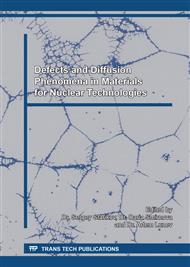[1]
I. I. Konovalov, B.A. Tarasov and E.M. Glagovskiy, Structurally-phase state and creep of mixed nitride fuel, 2016 IOP Conf. Ser.: Mater. Sci. Eng. 130 012030.
DOI: 10.1088/1757-899x/130/1/012030
Google Scholar
[2]
J.L. Routbort and R.N. Singh, Elastic, diffusional, and mechanical properties of carbide and nitride nuclear fuels – a review, J. Nucl. Mat. 58 (1975) 78-114.
DOI: 10.1016/0022-3115(75)90169-5
Google Scholar
[3]
D.J. Clough, Creep properties of oxide and carbide fuels under irradiation, J. Nucl. Mat. 65 (1977) 24-36.
DOI: 10.1016/b978-0-7204-0572-9.50008-3
Google Scholar
[4]
V.B. Malygin K.V. Naboichenko, A.S. Shapovalov, Yu.K. Bibilashvili, Recommendations for calculating the rate of irradiation-induced creep of oxide fuel when analyzing fuel-element serviceability, Atomic Energy 108/2 (2010) 121-126.
DOI: 10.1007/s10512-010-9266-3
Google Scholar
[5]
V.B. Malygin and A.N. Sokolov, Complex of experimental tools for investigation of irradiation creep and dimensional stability of fuel for power reactors, Engineering Physics 4 (2004) 27-30.
Google Scholar
[6]
D. Brucklacher and W. Dienst, Creep behavior of ceramic fuels under neutron irradiation, J. Nucl. Mat. 42/3 (1972) 280-285.
DOI: 10.1016/0022-3115(72)90079-7
Google Scholar
[7]
D.J. Clough, Observations on the low-temperature creep properties of uranium carbide under irradiation, J. Nucl. Mat. 56 (1975) 279-286.
DOI: 10.1016/0022-3115(75)90044-6
Google Scholar
[8]
I.I. Konovalov, Theory and calculation of nuclear fuel swelling, VNIINM 2001-3, 2001 (in Russian).
Google Scholar
[9]
C.S. Olsen, Steady-State Creep Model for UO2, Trans. Amer. Nucl. Soc. 22 (1975) 210-211.
Google Scholar
[10]
I.I. Konovalov et al., Effective displacement per atom – edpa, Computer program (2014) № 2014613852 (in Russian).
Google Scholar
[11]
Hj. Matzke, Atomic mechanisms of mass transport in ceramic nuclear fuel materials, J. Chem. Soc. Faradey Trans. 86 (1990) 1243-1256.
DOI: 10.1039/ft9908601243
Google Scholar
[12]
Hj. Matzke, Point Defects and Transport Properties in Carbides and Nitrides, Studies in Inorg. Chem. 9 (1989) 353-384.
Google Scholar
[13]
M.H. Bradbury and Hj. Matzke, Self-diffusion of plutonium in high burnup simulated (U, Pu)(C, N) and (U, Pu)N, J. Nucl. Mat. 91/1 (1980) 13-22.
DOI: 10.1016/0022-3115(80)90027-6
Google Scholar
[14]
P. Zeisser , G. Maraniello, C. Merlini, In-pile measurement of fission enhanced creep and swelling of uranium nitride, J. Nucl. Mat. 65 (1977) 48-60.
DOI: 10.1016/b978-0-7204-0572-9.50010-1
Google Scholar
[15]
S.I. Porollo, A.A. Ivanov, Yu.V. Konobeev et al., Swelling and radiation creep of three Russian austenitic steels irradiated by neutrons in a wide dose range and temperatures. Atomic Energy. 110/4 (2011) 207-214.
DOI: 10.1007/s10512-011-9419-z
Google Scholar
[16]
A.M. Dvoriashin, S.I. Porollo, Yu.V. Konobeev et al. Mechanical properties and microstructure of three Russian ferritic/martensitic steels irradiated in BN-350 reactor to 50 dpa at 490 °C, J. Nucl. Mat. 361-370 Part A (2007) 92-96.
DOI: 10.1016/j.jnucmat.2007.03.161
Google Scholar
[17]
M.B. Toloczko, F.A. Garner, S.A. Maloy, Irradiation creep and density changes observed in MA957 pressurized tubes irradiated to doses of 40–110 dpa at 400–750 °C in FFTF, J. Nucl. Mat. 428 (2012)170-175.
DOI: 10.1016/j.jnucmat.2012.04.005
Google Scholar


